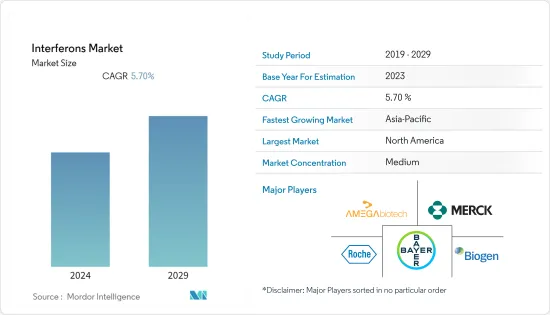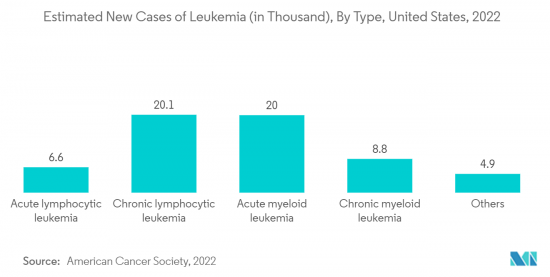Need help finding what you are looking for?
Contact Us
PUBLISHER: Mordor Intelligence | PRODUCT CODE: 1406898

PUBLISHER: Mordor Intelligence | PRODUCT CODE: 1406898
Interferons - Market Share Analysis, Industry Trends & Statistics, Growth Forecasts 2024 - 2029
PUBLISHED:
PAGES: 110 Pages
DELIVERY TIME: 2-3 business days
SELECT AN OPTION

The interferons market is expected to register a CAGR of 5.7% over the forecast period.
Key Highlights
- COVID-19 had a significant impact on the interferon market owing to the use of interferons for treating COVID-19 infection. For instance, a study published in September 2021 in the Journal of Medical Virology stated that interferon-alpha, in combination with ribavirin and polyethylene glycol molecule, has shown significant anti-viral properties without adverse reactions for treating COVID-19. The clinical trial studies regarding the development of interferons also contributed to the market growth during the later phase of the pandemic. For instance, in November 2021, BetterLife Pharma Inc. subsidiary, Altum Pharmaceuticals Inc., and Pontificia Universidad Catolica de Chile successfully completed the Phase 1 portion of Phase 1-2 randomized placebo-controlled trial (IN2COVID) in COVID-19 patients with better life's proprietary inhaled interferon alpha-2b product, AP-003. Therefore, the research studies on COVID-19 patients to assess the interferon intervention compensated for the market growth in the later phase of the pandemic. Currently, the market is gaining attention with innovative product launches for new COVID-19 variants and is expected to register a stable growth rate during the forecast period.
- In addition, the increasing prevalence of diseases such as hepatitis, multiple sclerosis, and cancers and the high target affinity and specificity of interferons are actively affecting the growth of the studied market.
- The interferon drugs market is projected to grow at a rapid pace in the forecast years due to the rising prevalence of chronic diseases such as hepatitis B, hepatitis C, cancer, and multiple sclerosis. For instance, according to data published by the American Academy of Pediatrics, in March 2022, more than 1 million people in the United States have long-term hepatitis B infections, and people who are infected with hepatitis B as a baby have a 90% chance of developing serious, chronic conditions like liver cancer in their lifetime. With the use of interferons as combination therapies and the advent of New Drug Delivery Systems (NDDS), the combination of Interferons with other drugs can be greatly enhanced and used in the treatment of hepatitis C, hepatitis B, cancer, and multiple sclerosis (MS). Therefore, the high burden of hepatitis B is expected to increase the demand for interferon for treating it, therefore driving the growth of the market.
- Similarly, according to data published by the World Health Organization (WHO) in July 2021, an estimated 58 million people have chronic hepatitis C virus infection, and about 1.5 million new infections occur annually. According to the same source, the hepatitis C virus is a blood-borne pathogen, and the most common form of infection is exposure to small amounts of blood. Further, as per the April 2022 report of the WHO, 11 countries in the WHO European Region and one country in the WHO Region of the Americas have reported a total of 169 cases of acute hepatitis of unknown origin as of 21st April 2022, which raises concern about the disease and hence, the demand for interferons is expected to increase, thereby fuelling growth in the market.
- The high burden of multiple sclerosis (MS) is expected to create an opportunity for the development of interferon-beta, which is expected to propel market growth. For instance, according to data published by Multiple Sclerosis Trust (MST), in September 2021, approximately 2,500,000 people in the world had multiple sclerosis (MS). Various market players are engaged in strategic initiatives such as product launches, approvals, and partnerships that are also contributing to market growth. For instance, in February 2021, Biogen Inc. received the United States FDA approval for a new intramuscular (IM) injection route of administration for PLEGRIDY (peginterferon beta-1a) for the treatment of relapsing forms of multiple sclerosis (MS). Thus, innovative launches to create more treatment options for MS market players are anticipated to propel market growth.
- Therefore, owing to the aforementioned factors, such as the high prevalence of chronic diseases like hepatitis and cancer along with product approvals, the studied market is anticipated to witness growth over the analysis period. However, the high research and development costs are likely to impede market growth.
Interferons Market Trends
Leukemia Segment is Expected to Hold a Significant Market Share Over The Forecast Period
- Interferon-alpha is most often used in treating chronic myeloid leukemia (CML). The segment is expected to show stable growth during the forecast period owing to the high burden of leukemia and rising product approvals and launches by market players.
- According to the American Cancer Society (ACS) 2022 report, 1.9 million new cancer cases were diagnosed in the United States in 2022. Out of the cancer cases, leukemia was reported with 60,650 new cases, and lymphoma with 89,010 new cases in the United States in 2022. Also, as per ACS 2021 facts, approximately every 3 minutes, one person in the United States is diagnosed with leukemia, lymphoma, or myeloma.
- Furthermore, according to the Leukemia Foundation 2022 update, 19,403 new Australians were diagnosed with a blood cancer such as leukemia, lymphoma, and myeloma in 2022. This was equivalent to 53 people daily or one person every 27 minutes. The same source stated that 135,000 individuals were living with blood cancer in Australia in 2022, and more than 275,000 Australians are expected to be living with blood cancer by 2035. Thus, the high burden of leukemia worldwide is expected to propel the segment growth during the forecast period.
- Additionally, the strategic initiatives by market players, such as product approvals and launches, as well as partnerships, are also contributing to the segment growth during the forecast period. For instance, in November 2021, PharmaEssentia Corporation, a global biopharmaceutical innovator based in Taiwan, received U.S. FDA approval for BESREMi (ropeginterferon alfa-2b-njft) for the treatment of adults with polycythemia vera (PV). It is a rare blood cancer that can proceed to cause myelofibrosis and other malignancies, such as acute myeloid leukemia, if left untreated. The approvals of advanced interferons for the treatment of leukemia are projected to expand the segment's growth.
- Therefore, owing to the high burden of leukemia, the company's research and development for developing an innovative product are anticipated to propel the segment's growth during the forecast period.

North America is Expected to Hold a Significant Market Share Over the Forecast Period
- North America is expected to hold a significant share of the interferon market due to the high burden of cancer coupled with developed medical and healthcare establishments and the availability of products in the region.
- According to the ACS 2022 report, melanoma of the skin reported 99,780 new cases in 2022 in the United States. Also, in 2022, 79,000 new cases of renal cancer were diagnosed in the United States. Most kidney cancers are renal cell carcinomas. Hence, the high burden of melanoma and renal cell carcinoma in the region is expected to propel the market growth during the forecast period.
- Furthermore, the data published in the Viral Hepatitis National Strategic Plan: 2021-2025 report for the United States, updated in January 2021, stated that people who have underlying medical disorders, such as those who have chronic liver diseases like hepatitis B and C, may be more susceptible to developing severe illnesses from COVID-19. Therefore, the demand for the interferons market will significantly be higher in the North American region as the patient population is increasing compared to other countries.
- In addition, the presence of key market players, coupled with growing awareness programs and the introduction of the latest products in the region, is responsible for bolstering the market's growth in the United States. Moreover, in January 2022, Synairgen plc, the respiratory company developing SNG001 (inhaled interferon-beta or IFN-beta) for the treatment of COVID-19 as potentially the first host-targeted, broad-spectrum antiviral treatment delivered directly into the lungs, partnered with global experts in strategic engagement and commercialization, Ashfield Engage. Also, in November 2021, Synairgen completed the enrolment of 610 patients in its Phase 3 SPRINTER trial (SG018). SNG001 has also recently graduated to the Phase 3 part of the US National Institute of Health's ACTIV-2 trial. Thus, such clinical trial developments for interferon in the region are expected to boost the growth of the market in the region over the forecast period.
Interferons Industry Overview
The interferons market is slightly consolidated and consists of local as well as global players. In terms of market share, a few of the major players are currently dominating the market. Some of the companies that are currently dominating the market are Merck & Co., Inc., Biogen Inc, Bayer AG, Amega Biotech, and F. Hoffmann-La Roche Ltd.
Additional Benefits:
- The market estimate (ME) sheet in Excel format
- 3 months of analyst support
Product Code: 72391
TABLE OF CONTENTS
1 INTRODUCTION
- 1.1 Study Assumptions and Market Definition
- 1.2 Scope of the Study
2 RESEARCH METHODOLOGY
3 EXECUTIVE SUMMARY
4 MARKET DYNAMICS
- 4.1 Market Overview
- 4.2 Market Drivers
- 4.2.1 Increasing Prevalence Of Diseases Such As Hepatitis, Multiple Sclerosis, And Cancers
- 4.2.2 High Target Affinity And Specificity Of Interferons
- 4.3 Market Restraints
- 4.3.1 High R&D Costs
- 4.4 Porter's Five Forces Analysis
- 4.4.1 Threat of New Entrants
- 4.4.2 Bargaining Power of Buyers/Consumers
- 4.4.3 Bargaining Power of Suppliers
- 4.4.4 Threat of Substitute Products
- 4.4.5 Intensity of Competitive Rivalry
5 MARKET SEGMENTATION (Market Size by Value - USD)
- 5.1 By Service
- 5.1.1 Inteferon Alpha
- 5.1.2 Inteferon Beta
- 5.1.3 Inteferon Gamma
- 5.2 By Application
- 5.2.1 Hepatitis B
- 5.2.2 Hepatitis C
- 5.2.3 Melanoma
- 5.2.4 Leukemia
- 5.2.5 Multiple Sclerosis
- 5.2.6 Renal Cell Carcinoma
- 5.3 Geography
- 5.3.1 North America
- 5.3.1.1 United States
- 5.3.1.2 Canada
- 5.3.1.3 Mexico
- 5.3.2 Europe
- 5.3.2.1 Germany
- 5.3.2.2 United Kingdom
- 5.3.2.3 France
- 5.3.2.4 Italy
- 5.3.2.5 Spain
- 5.3.2.6 Rest of Europe
- 5.3.3 Asia-Pacific
- 5.3.3.1 China
- 5.3.3.2 Japan
- 5.3.3.3 India
- 5.3.3.4 Australia
- 5.3.3.5 South Korea
- 5.3.3.6 Rest of Asia-Pacific
- 5.3.4 Middle East and Africa
- 5.3.4.1 GCC
- 5.3.4.2 South Africa
- 5.3.4.3 Rest of Middle East and Africa
- 5.3.5 South America
- 5.3.5.1 Brazil
- 5.3.5.2 Argentina
- 5.3.5.3 Rest of South America
- 5.3.1 North America
6 COMPETITIVE LANDSCAPE
- 6.1 Company Profiles
- 6.1.1 Amega Biotech
- 6.1.2 Bayer AG
- 6.1.3 Biogen Inc
- 6.1.4 Biosidus
- 6.1.5 Merck & Co.,Inc.
- 6.1.6 Novartis AG
- 6.1.7 Pfizer Inc
- 6.1.8 F. Hoffmann-La Roche Ltd
- 6.1.9 Zydus Cadila
- 6.1.10 AOP Orphan Pharmaceuticals AG
7 MARKET OPPORTUNITIES AND FUTURE TRENDS
Have a question?


SELECT AN OPTION
Have a question?


Questions? Please give us a call or visit the contact form.
